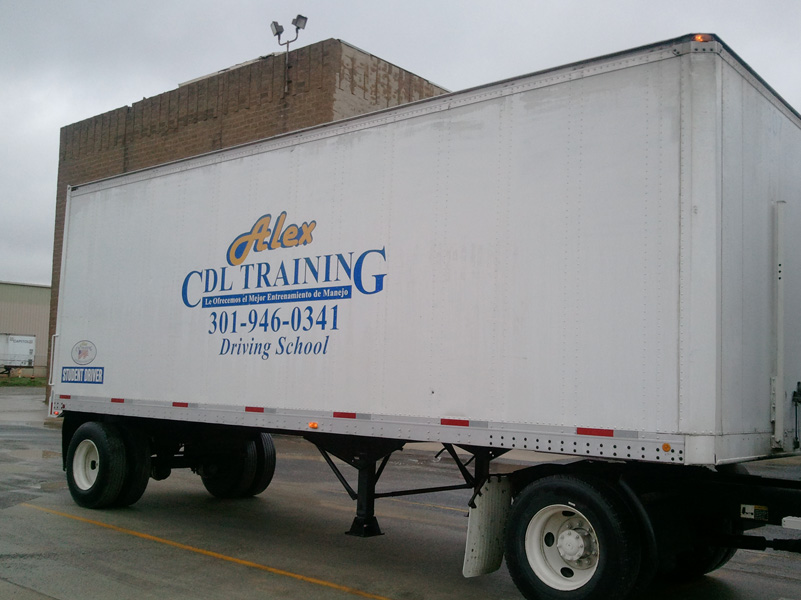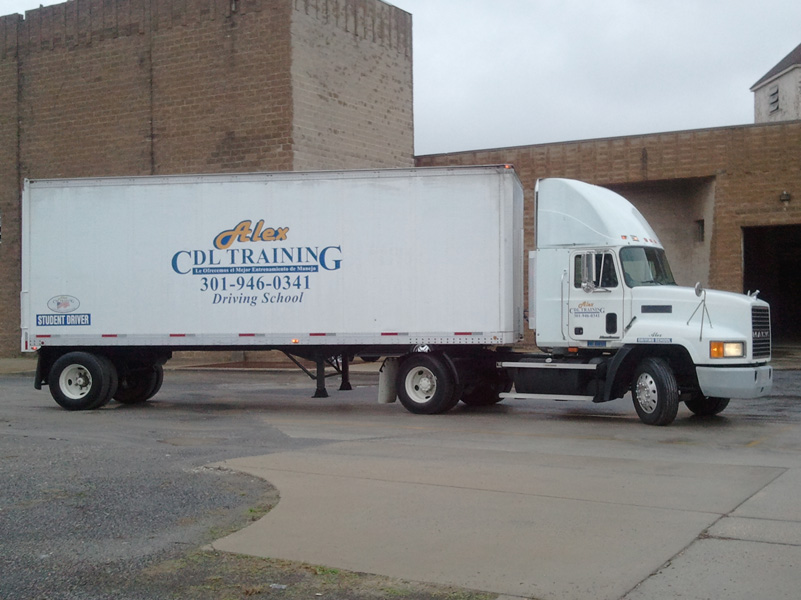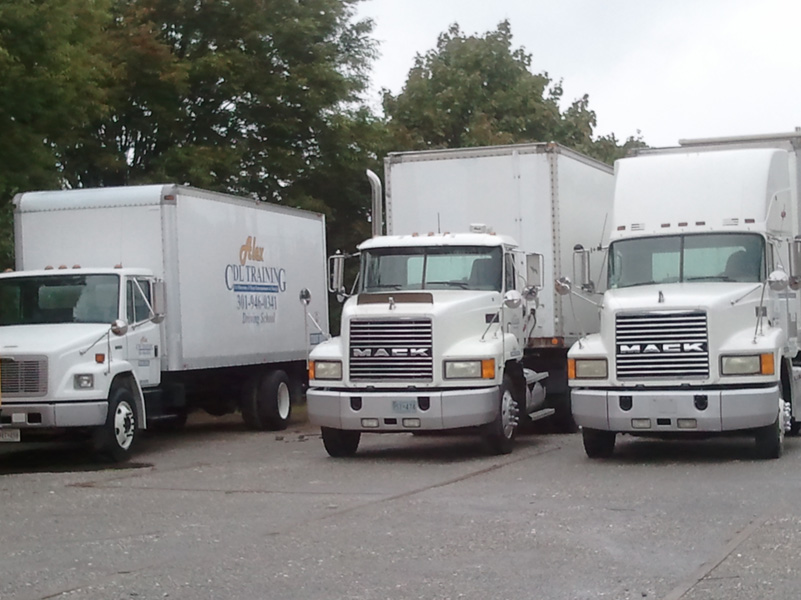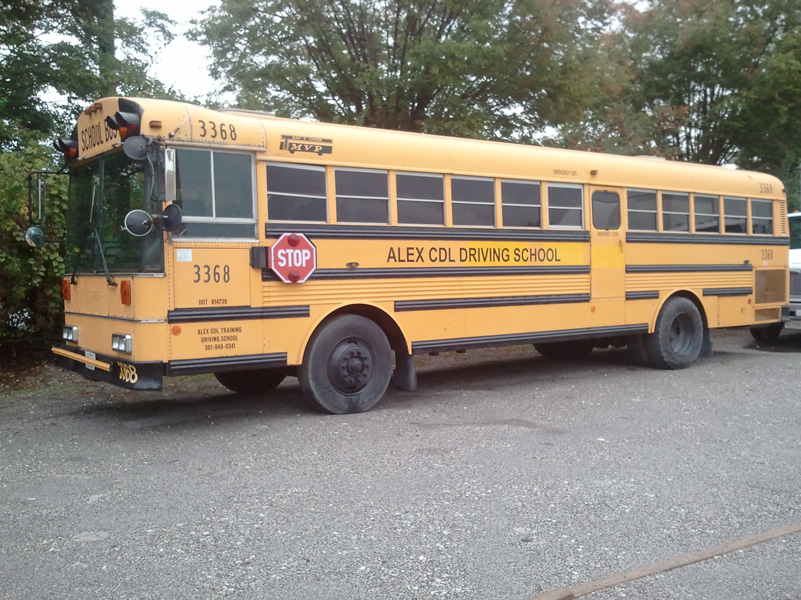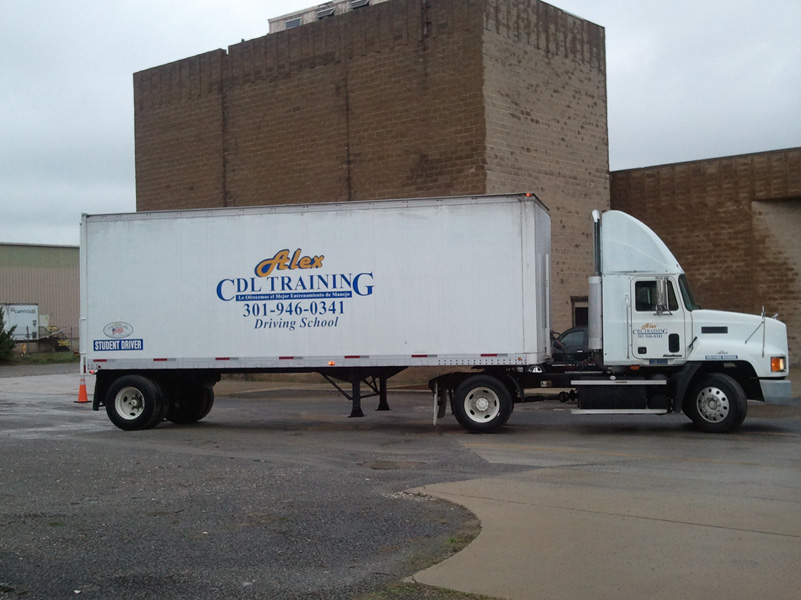All Alex CDL programs are backed by the MVA
-
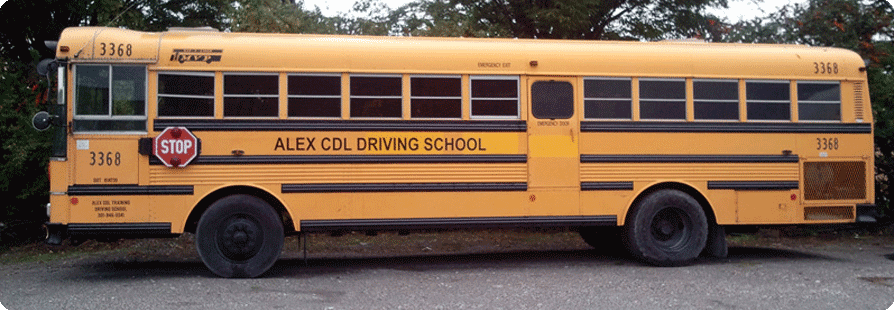
Learn to drive a truck
To get better job opportunities -

All Alex CDL programs
Are backed by the MVA -

Learn to drive a truck
To get better job opportunities -

All Alex CDL programs
Are backed by the MVA
Look our students driving a truck
Frequently Asked Questions
After the driver is trained and learns to maneuver the truck, a driving skills exam is administered by the state (some states allow private "third party testers" to administer the test on behalf of the state). The driver must demonstrate he/she knows how to inspect the vehicle prior to operating it, how to conduct an air brake test and then demonstrate basic parking, backing and other driving skills. The driving skills test takes place on a closed driving range as well as public roads. Although the process of getting a CDL is straight forward, it takes time to learn the information necessary to pass the written knowledge tests, the inspection and air brake exams and the driving skills test. Plus there is a lot of information beyond what is needed to get your CDL that you need to know. Good schools focus on this.
It is very important to get as much good classroom instruction as you can for the written CDL tests. This is the fundamental information upon which your career will be built. It is your starting point, so be sure to find a school that offers a course which includes a good basic CDL preparation class. Some schools require you to take the tests after self-study (in other words, you have get your CDL permit on your own). And other schools may only give you the bare minimum instruction necessary to pass the test. We don't recommend these types of programs. You may get your license this way, but you probably won't have the knowledge you need to drive safely. "Quick and dirty" schools like this focus only on minimum driving skills so that you pass the driving test to get your CDL. That way you are "out the door" faster. These schools graduate a lot of students and are known as "CDL Mills". We definitely recommend a more complete course that offers a combination of live instructors, video or computer-based training and practice CDL tests. You should be able to ask questions of instructors and review your tests with them.
TYPES OF SCHOOLS: There are essentially three different types of truck driver training programs. The first is a private school, the second is a public institution and the third is a training program run by a motor carrier. That being said, there are typically significant differences that we'll explain below.
Private Schools: These schools are owned and operated by private, for-profit entities (such as a corporation or a partnership). Their business is to provide training for students interested in the trucking industry. The advantage to going to a private school is that they are there for one purpose only: to train drivers for America's trucking companies. They will only make money and be in business if they do this well. Private schools that have minimal or poor training standards will not be in business for very long. So their incentive is to make sure that students are satisfied. However, the flip side to this point is that as a for-profit school, the "bottom line" (financial condition) is important. Some private schools may try to cut costs and improve profit. This is usually done by cutting the quality of the training by skimping on skill training or by providing only the minimal amount of training necessary to get the student a CDL. The good news is that reputations form easily in the trucking school business. Schools that compromise safety or skill development for the sake of profit usually develop a poor reputation (See our discussion of CDL Mills). The other factor to consider is that private schools are usually required to be licensed and are regulated by most states. This means that there is an independent third party that enforces the laws and regulations that govern schools of this type in that state (see State Regulation below). If you have a complaint, you should let the state agency know. Let us know too!
Public Institutions: These are schools that are chartered, owned, operated and funded by a state or local government. They are frequently called "publicly funded" truck driving schools for this reason. Examples of these types of schools include local community colleges, vocational-technical schools (Vo-Techs) or state colleges. At publicly funded truck driving schools, the truck driving program is only one of many courses that are taught at the school. For example, a public school may offer computer training, welding, automotive technology, accounting, and many other courses in addition to truck driving. So a key question to answer for yourself is this: will you get the attention you need in this program or is truck driving just one of the 250 courses they offer? Often an advantage to a publicly funded school, however, is the cost. Since these schools are "publicly funded," the cost of programs may be subsidized in some manner by the state or local government. Costs are supposed to be lower as a result. But you need to compare prices (and the curriculum) to determine if this is the case. Sometimes these programs accept only a few students per class, so the charge per student remains high. Another issue is that public institutions are sometimes less flexible than private schools. If you want a more customized program or need flexibility with class hours, for example, a private school can be easier to work with. Public schools usually have a set number of classes per year, and that's it. If you miss the first class, you may have to wait 10 or 15 weeks to start. Whereas a private school is in a better position to alter the schedule to fit your needs. Lastly, public school programs are sometimes much longer than private schools. This can be good if the training is more thorough. But if you are out of work and want to start driving and earning a paycheck quickly, a longer program may not be the best answer for you.
Motor Carrier Training Watch out! This is training where -- literally -- "the rubber meets the road." These are truck driving "schools" that are being run for one reason only: the company doing the training wants as many drivers as possible, usually in as short a period as they can. The objective is simply to get drivers on the road hauling freight so the company can make more money. We do not recommend this type of training and warn that you be VERY careful if you choose this route. This type of training is not really a school at all. It is really an on the job training program. It is designed to give an individual minimal driving skills necessary to pass the CDL test. Then the driver can begin running freight with a "driver-trainer," who is usually just another driver with a little more experience.
CERTIFICATION: In the truck driving school business, Certification is different from state licensing. A certified truck driving school is one that has been "certified" to meet the trucking industry's training standard. Certification means that an independent third party (in other words someone unrelated to the school) has inspected the school and "certified" that the training should result in a graduate that has the basic skills to be an entry-level truck driver. It has nothing to do with state licensing or accreditation. Certification is becoming increasingly important to employers and state agencies that fund training for students.
There is only one organization that currently certifies truck driving courses: The Professional Truck Driver Institute (PTDI), located in Alexandria, Virginia. PTDI certification is voluntary. A school is not required to become certified. But a certified school is probably the best guarantee that a truck driving school maintains high truck driver training standards.
PTDI has developed three sets of strict standards that they apply to truck driving schools that want to be certified. PTDI will inspect the school and determine whether the standards are met. If they are met, the school's course is certified (schools are not certified) and the school can advertise that it teaches a course certified by PTDI. The three standards are for Skills, Knowledge and Curriculum. Skill standards are the basic skills an entry level driver should have (shifting, backing, vehicle inspection, etc.). As you might guess, knowledge standards describe the basic information a driver should know (how to plan a trip, licensing requirements, accident procedures and cargo documentation, for example). Finally, PTDI's curriculum standards identify the minimum course of instruction a truck driving school must present, including topics addressed and hours required for class, truck lab and driving. PTDI's standards for a school in this regard are very high. For example, PTDI requires that every student individually have at least 44 hours of driving instruction behind the wheel. That's a lot of driving time, and it cannot include any hours observing. (See Observation Time below).
There a number of advantages to PTDI certification. Students know that the training should be high quality, that they will receive a lot of driving experience and that the school has made the extra effort to demonstrate it is committed to the best training. Plus, the trucking industry has great respect for PTDI graduates because they know they are getting the best. They also know that their own company "finishing training" training costs will be lower because the student is well trained already. So, students that graduate from a top quality program benefit in the wallet as well because they require less training by the employer. Therefore they can drive solo sooner and earn more money faster. New drivers that attend short programs or get inadequate training can get stuck in the carrier's training program at a low weekly pay rate for a long time. We think PTDI sets a great standard that benefits everyone!
Even if a school is not certified, you can ask one important question to see if they adhere to higher standards: exactly how many hours of actual driving is provided to every student? Remember that PTDI requires 44 hours for every student. And that does not mean you're simply "in the truck" for 44 hours. Some schools place 3-5 students in the truck at the same time for full day drives and simply rotate the students into the driver's seat for one or two hours; they may call all this time "behind the wheel." PTDI requires 44 hours of actual driving. So make the school tell you the specific number of hours you will be driving, and ask them to show you their guaranteed driving time in writing. Don't accept answers like "we give you as much time as you need". A good school will identify driving hours in their catalog or informational brochure. After all, you are attending a truck driving school -- driving is the basic skill and you should expect a lot of practice driving!
That being said, a truck driving school should have "late model" equipment that is safe and well maintained. Late model means that the equipment should not be out of date. It should be close to what the student can expect to drive with a company. But most companies buy new tractors every few years, so their equipment is basically new (or only a few years old). A school usually cannot do this. Although schools cannot have ALL new equipment, they should have at least one truck that is only four to five years old for use in street driving. For driving maneuvers on a practice driving yard (backing, coupling, parking etc.) most schools will have equipment that is up to 10 years old (or older). That is OK as long as the vehicle is used just for private driving yard practice.
We also note that ALL trucks should be safe and well maintained. You should get an idea of the maintenance just by looking at and listening to the truck. Ask the school how often the truck is inspected. Ask to see when the last inspection was conducted. The truck should have basic items for safety such as a fire extinguisher, traffic warning triangles and an accident report kit. If you have questions about truck safety, ask the school staff. You can also check with the state and federal Department of Transportation regarding the safety record of a company. Always ask to see a copy of the truck insurance before you drive on public streets. An insurance card must always be with any vehicle driven on the road.
The military also has several programs to assist service members separating from the service. For example, the Transition Assistance Program (TAP) is administered jointly by the Department of Veteran’s Affairs and the Department of Labor’s Veterans Employment and Training Service (VETS). Under TAP, service members are provided workshops and information on employment and training options after leaving the service. Disabled vets have a special DTAP program available in addition to local Vocational Rehabilitation (VocRehab) office assistance. Finally, service members with veterans educational benefits may be able to have certain costs of truck driver training funded. Ask the truck driving school if they accept VA funding. Schools must be in business for two years prior to VA approval, which is handled by state VA representatives.
A word of caution: be very specific when you ask school staff how many hours you will be driving. How many hours will you drive on the practice range? How many on public streets? Almost all schools describe their training in terms of clock hours ("our program is 148 hours long", for example). Some schools will describe the time in the truck as the hours of training "behind the wheel" (BTW). But be careful. Make sure that BTW time is the same thing as student driving time. Many truck driving schools include all time that a student is physically sitting behind the wheel as BTW time. This includes the time you are sitting in the cab watching another student drive. Although you are literally "behind the wheel," you are not actually driving.
Unfortunately, some schools are dishonest about this. They describe BTW hours as if they are all driving hours. A school may state that every student will get 75 hours "behind the wheel." A natural conclusion is that each student will actually hold on to the steering wheel and drive for 75 hours. This may not be true if the school includes student observation time in the 75 hours. For example, a school may include two hours of observation time for every 1 hour of driving. So a student will spend two out of every three hours sitting in the back watching another student drive. Using the example of 75 hours, that means that a student is watching for about 50 hours and only driving for about 25 hours. This falls far short of the PTDI standard of 44 hours, although a student that did not know about observation time might enroll in the school thinking that he would get 75 hours of practice driving.
Including observation time can be OK if there is enough actual driving time and the rest of the truck driving course has a sufficient amount of class and truck lab. A problem arises when the course is short and includes observation time. For example, a course might be only 120 hours long and be described as having 75 hours of "behind the wheel" training. But if 50 hours are simply student observation, there are only 25 hours of driving and 45 hours of class and truck lab. The course would not provide adequate training.
The other issue is how much a student is paying for a course. A program that includes observation time can cause students to overpay for training. As a general rule, the more driving time, the better the value of the program. For example, a 160 hour program that costs $3,800 and includes the PTDI-recommended 44 hours of driving is a much better value than a 160 hour course that only includes 20 or 30 hours of actual driving. This is because driving is the basic skill that truck driving schools teach - it is the heart of the school’s course, and it is what a student is really paying for. But a school that includes student observation in its curriculum may describe it as "50 hours behind the wheel" even though actual driving time is a lot less than 50 hours. So when comparing truck driving courses, you have to ask how much driving time is included. Demand a guarantee of driving hours in writing. While 44 hours of driving time is the highest industry standard, anything less than 30 hours per student is probably insufficient.
 English
English  Español
Español 

